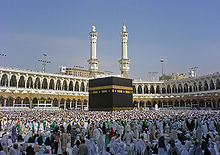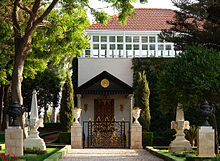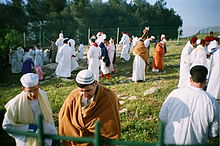- List of significant religious sites
-
For the term "Most Holy Place" as used in the King James Version of the Bible, see Holy of Holies.See also: Sanctum sanctorum
This article provides a list of significant religious sites.
Contents
Bahá'í faith
Located in Bahji near Acre, Israel, the Shrine of Bahá'u'lláh is the most holy place for Bahá'ís and their Qiblih, or direction of prayer. It contains the remains of Bahá'u'lláh, founder of the Bahá'í Faith and is near the spot where he died in the Mansion of Bahji. The second holiest site is the Shrine of the Bab in Haifa. Jerusalem is also considered a holy place.[1]
Buddhism
Main articles: Vajrashila, Bodhi Tree, Mahabodhi Temple, and Bodhgaya The Bodhi Tree at the Mahabodhi Temple in India. The tree was initially propagated from the Sri Maha Bodhi, which in turn is propagated from the original Bodhi Tree at this location.
The Bodhi Tree at the Mahabodhi Temple in India. The tree was initially propagated from the Sri Maha Bodhi, which in turn is propagated from the original Bodhi Tree at this location.
Bodhgaya, in the state of Bihar in India, is considered by many adherents of Buddhism to be their most holy site. Gautama Buddha is said to have attained enlightenment while sitting under a peepal tree, called the Bodhi tree, located in Bodhgaya. At this site of his purported enlightenment the Mahabodhi temple now stands. Every year, many Buddhists make pilgrimages from all over the world to visit and meditate at the temple.
Shugendō
Main articles: Sanzan Gosaiden, Mount Haguro, and Three Mountains of DewaShugendō is a small, syncretic, highly esoteric and ascetic sect or sub-sect of Buddhism (mostly related to, and often considered a distinct branch of the Tendai and Shingon schools) combining elements of Zen, Taoism, Koshintō, Japanese folk animism and shamanism. The faith is traditionally believed to have been founded by the śramaṇa and mystic-sorcerer En no Gyōja in the 7th or 8th century. In the same manner as the religion of Shintō, Shugendō is largely relegated to the East Asian country of Japan.
The lay practitioners and monks of Shugendō, called Shugenja or yamabushi respectively, venerate mountains as both spiritual areas and, along with nature as a whole, "natural maṇḍalas" .
Adherents of Shugendō consider the collective Three Mountains of Dewa (consisting of Mount Haguro, Mount Gassan, and Mount Yudono), located in the remote Dewa Province of Japan, to be their most sacred of places. The three mountains are also sacred in Shintō.
Christianity
Main articles: Church of the Holy Sepulchre, St Peters, Rome, and Canterbury CathedralSee also: List of Christian holy sites in the Holy LandLocated in the Christian Quarter of the Old City of Jerusalem, the Church of the Holy Sepulchre is the most holy site for many mainstream denominations within Christianity. This is the site, according to their understanding, where Jesus Christ was crucified, died, buried and resurrected from the dead. The Greek Orthodox Church of Jerusalem, Roman Catholic Church, and Armenian Apostolic Church form the custodians of this most holy place and collectively control the most holy pilgrimages within the church along with the Coptic, Syriac, and Ethiopian Orthodox churches who also hold some chapels.
The Catholic Church
The Catholic Church regards Jerusalem, Nazareth, Bethlehem, Capharnaum and many other places in the Holy Land as sacred places since the apostolic times, and also regards as places of special sanctity the sanctuaries built on the tombs of the Apostles. Rome holds two main basilicas which were built over the tombs of the apostles Peter and Paul, these basilicas together to Saint Mary Major, and Saint John of Letran, are the four major basilicas of Rome.
Spread around the World there are also many marian sanctuaries. A marian sanctuary is that, which honors the Mother of God, the Virgin Mary. To say:
Basilica of Our Lady of Guadalupe in México.
Sanctuary of Our Lady of Lourdes in France.
Sanctuary of Our Lady of Fátima in Portugal.
Basilica of Our Lady of the Forsaken in Spain.
The Catholic Church only has a single cult to the One God, those sanctuaries which honor the The Virgin Mary, The Apostles, or the saints are not intended as temples for the cult of them but as places which honor with special focus their exemplar lives, in their loyalty to God.
Latter-day Saints
The most holy place for members of The Church of Jesus Christ of Latter-day Saints may be considered a room in the Salt Lake Temple designated as the "Holy of Holies".
Latter-day Saints, however, may regard LDS temples in general to be their most holy place. The Bible Dictionary in the LDS edition of the Bible states:
"A temple is literally a house of the Lord, a holy sanctuary in which sacred ceremonies and ordinances of the gospel are performed by and for the living and also in behalf of the dead. A place where the Lord may come, it is the most holy of any place of worship on the earth. Only the home can compare with the temple in sacredness" [1].
Other sacred sites for Latter-day Saints include the Sacred Grove and Adam-ondi-Ahman, as well as sites considered sacred by Christianity in general, such as the Garden of Gethsemane and Garden Tomb.
Confucianism
Main articles: Kong Miao and QufuDruzism
 Jethro's Tomb in Tiberias, Israel
Jethro's Tomb in Tiberias, Israel
The Tomb of Jethro, known as Nabi Shu'ayb, near Tiberias in Israel is the most important religious site for the Druze community. The Druze have held religious festivals there for centuries and it has been a place of annual pilgrimage.
Hinduism
The Indian city of Varanasi, Uttar Pradesh is said to be the most holy city in Hinduism. It is considered by many to be the most sacred place of pilgrimage for Hindus irrespective of denomination.
The "garbha griha" (literally womb-house or womb-chamber), the shrine inside a temple complex where the main deity is installed in an area that is in a separate building by itself inside the complex, is the most sacred site within the temple complex.
The garbha griha usually contains the murti (idol or icon), the primary focus of prayer. In temples with a spire or vimana, this chamber is placed directly underneath it, and the two them form a main vertical axis of the temple. These together may be understood to represent the axis of the world through Mount Meru. The garbha griha is usually also on the main horizontal axis of the temple which generally is an east-west axis. In those temples where there is also a cross-axis, the garbha griha is generally at their intersection.
Islam
 Pilgrims circumambulating the Kaaba during the Hajj
Pilgrims circumambulating the Kaaba during the Hajj
The Kaaba in Mecca, Saudi Arabia, according to Islamic tradition was rebuilt by Ibrahim and his son Ismail, and is the holiest place in Islam. The second holiest place is the Masjid al-Nabawi in Medina, which is where Prophet Muhammad is buried under the Green Dome. Caliphs Umar and Abu Bakr are also said to be buried in the Masjid al-Nabawi. The Al-Aqsa Mosque in Jerusalem is a sacred place in Sunni traditions as the site from which Prophet Muhammad ascended to heaven in the Isra and Mi'raj and was also the first qibla. Mount Sinai also holds significance in Islam.[2] Among Shias, the Imam Ali Mosque and Imam Husayn Shrine also hold high significance.
Jainism
Main articles: Jalmandir and PawapuriJainism (Hindi: Jain Dharma, Tamil: சமணம் Samanam, Pali (archaic): Nirgrantha Dhamma) is a Dharmic religion similar in belief and practice to other Indian traditions, especially Buddhism as well as Hinduism – the former to which it shares many comparable ties and some near-identicalities philosophically, doctrinally and historically. (Particularly the notions of nontheism, nirvana, and nonviolence.)
A temple complex and the site around which it is based, both collectively known as the Jalmandir, stands amid a "lotus pond" in the East Indian locality of Pava, more commonly referred to as Pawapuri or the Pawapuri (Hindi: पावापुरी, Urdu: پوا پوری; also called Apapuri (the sinless town), and revered as Madyama Pawa or Apawapuri by the honorific, early Jain disciple Ajatshatru). Pawapuri is attested as the place where the 24th Tirthankara, the formal organizer and traditional founder of Jainism, Mahavira, attained enlightenment. It is also the location of his death and funeral and a place where he often stayed for residence. It is situated in the Nalanda district in the state of Bihar
Jains consider Pawapuri to be their most important tirtha (pilgrimage site).
Judaism
See also: Kodesh Hakodashim, Land of Israel, Little Western Wall, Warren's Gate, Western Stone, Western Wall Tunnel, and Wilson's ArchJudaism (from Judah, a derivation of the Hebrew יהודה Yehudah) is an ancient Abrahamic religion dating to the Iron Age Levant, which traces its origins (eponymously, along with most other Abrahamic faiths) to the patriarchal prophet Abraham. The history of the Jewish faith is intertwined with much of the course of Western and Middle-Eastern tory through the consequent traditions of Christianity and Islam.
 A modern diagram of the Kodesh Hakodashim, or the tabernacle at Solomon's Temple.
A modern diagram of the Kodesh Hakodashim, or the tabernacle at Solomon's Temple.
The Kodesh Hakodashim (Biblical Hebrew: קֹדֶשׁ הַקָּדָשִׁים Qṓḏeš HaqQŏḏāšîm), Judaism's Holy of Holies, was the inner sanctuary of the Tabernacle in the time of Moses as described in the Torah; the term now refers to the space on the Temple Mount in Jerusalem where this sanctuary was located in the Temple in Jerusalem. (This location is often, but controversially, identified as being inaccessible within the footprint of the Islamic Dome of the Rock.) Historically, it could be entered by the High Priest only on Yom Kippur. Orthodox Judaism and Conservative Judaism continue to regard the location as retaining some or all of its sanctity despite the destruction of the Temple in 70 CE. Entry into sanctified areas has been prohibited in recent times by powerful elements within traditional Judaism, and as a result many religious authorities prohibit or restrict entry into the Temple Mount by observant Jews.
Today, Jews recognize the Jewish Quarter of the city, wherein the Mount is located, to be a location of profound spiritual importance. Within the area a stone artifact known as the Western Wall is paramount as the last standing remains of the temple. Along the wall notable featured include the Western Stone and Wilson's Arch. Beneath it a tunnel runs closer toward what was the original Kodesh Hakodashim, ending approximately 150 ft. inward at a place called Warren's Gate. In an alley the Muslim Quarter of the city is a semi-concelead section of the Wall called the Little Western Wall.
The Cave of the Patriarchs in Hebron is the second holiest site in Judaism. Other significant sites include a number of temples within the Jewish quarter of Old Jerusalem, namely the Hurva, Belz, Tiferet Yisrael and the Four Sephardic synagogues. The Beit El Synagogue is of special importance to students of Kaballah.
Samaritanism
Main articles: Holy Rock and Mount GerizimSee also: Kiryat Luza and NablusSamaritanism is a religion closely related to – or by some considered an early derivative of – Judaism, practiced by the Samaritan (Hebrew: שומרונים Shomronim, Arabic: السامريون as-Sāmariyyūn) ethnoreligious group, who mostly reside in the region of the Levant and claim ancestry to Israelites with connections to the ancient Eastern Mediterranean kingdom of Samaria. The Samaritan ethnoreligious group and the subsequent Samaritan religion are considered to be, demographically, the smallest of their kind in modern times, with the number of Samaritans worldwide totalling at just 712 as of late 2007.
Adherents of Samaritanism consider a formation known as the Holy Rock, atop the summit of Mount Gerizim (Samaritan Hebrew: Ar-garízim, Arabic: جبل جرزيم Jabal Jarizīm, T.H.: הַר גְּרִזִּים Har Gərizzîm, S.H.: הַר גְּרִיזִּים Har Gərizzim), to be their "holy of holies". This is comparable with the Temple Mount of Jerusalem as idealized and revered by mainstream Jews – however Gerizim is located near the Samaritan village of Kiryat Luza, adjacent to the Palestinian city of Nablus (present-day Biblical Shechem), in the West Bank.
Shinto
Main article: Ise ShrineIse Shrine is the formal home of Amaterasu ōmikami, the primary deity of Shinto and traditionally believed to be a direct ancestor of the Japanese Imperial Family. It is located in the city of Ise in Mie prefecture, Japan. Access is strictly limited, with the public allowed to see merely the thatched roofs of the central structures, hidden behind three tall wooden fences. The Ise Shrine is purportedly the home of the Sacred Mirror.
Sikhism
Harmandir Sahib, or Darbar Sahib (also known as the Golden Temple), is culturally the most important shrine in Sikhism, considered the spiritual and cultural centre of Sikhs. Located in Amritsar, Punjab, India. It is one of the oldest Sikh gurdwaras. It is located in the city of Amritsar, India, which was established by Guru Ram Das, the fourth guru of the Sikhs and the city was also built around the shrine, known as "Guru Di Nagri" meaning city of the Sikh Guru. It is made from white marble to keep the ground cool and pleasant. It was later laid with real Gold which was provided by the emperor of Sikh Empire, Maharaja Ranjit Singh.
Another significant place is the village of Nankana Sahib in Pakistan,the birthplace of Guru Nanak, founder of Sikhism. Each of Nankana Sahib's gurdwaras are associated with different events in Guru Nanak Dev's life. The town remains an important site of pilgrimage for Sikhs worldwide. Punjab province of Pakistan is also the location of many important religious and historical sites for Sikhs, including the place of martyrdom of fifth Sikh Guru, Guru Arjan Dev. Many other important Sikh Shrines are located in the Punjab state of India as well as other parts in India.
Zoroastrianism
Main article: UdvadaSee also
- Burial places of founders of world religions
- Holy of Holies
- Honden
- Pilgrimage
- Place of worship
- Sacred travel
References
External links
Wikimedia Foundation. 2010.











